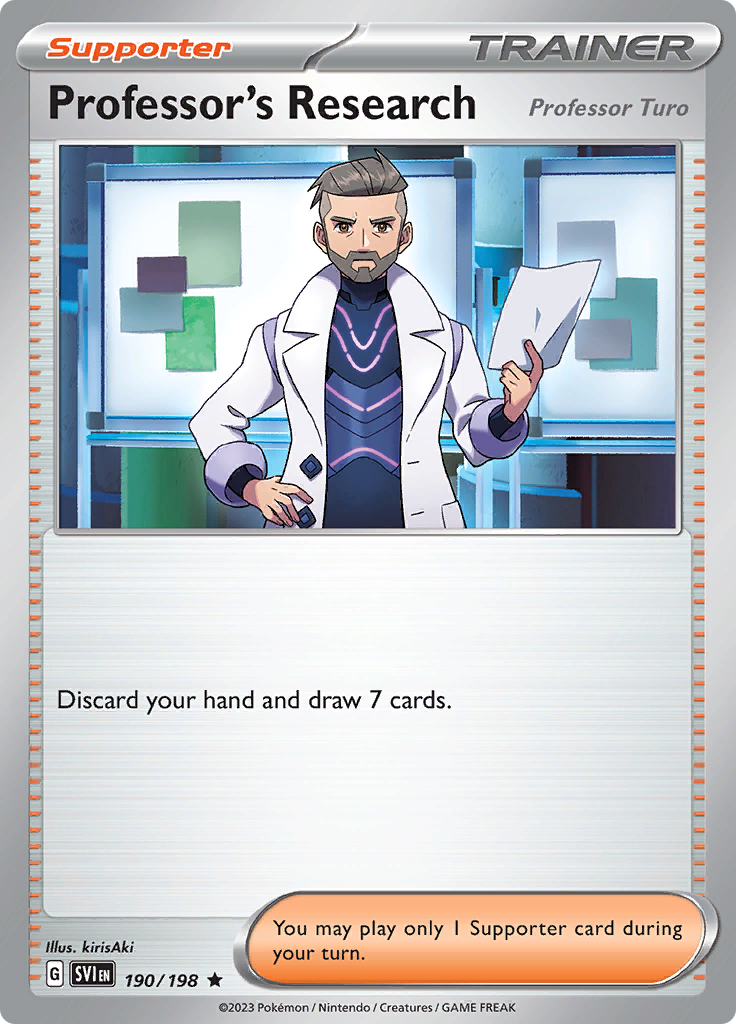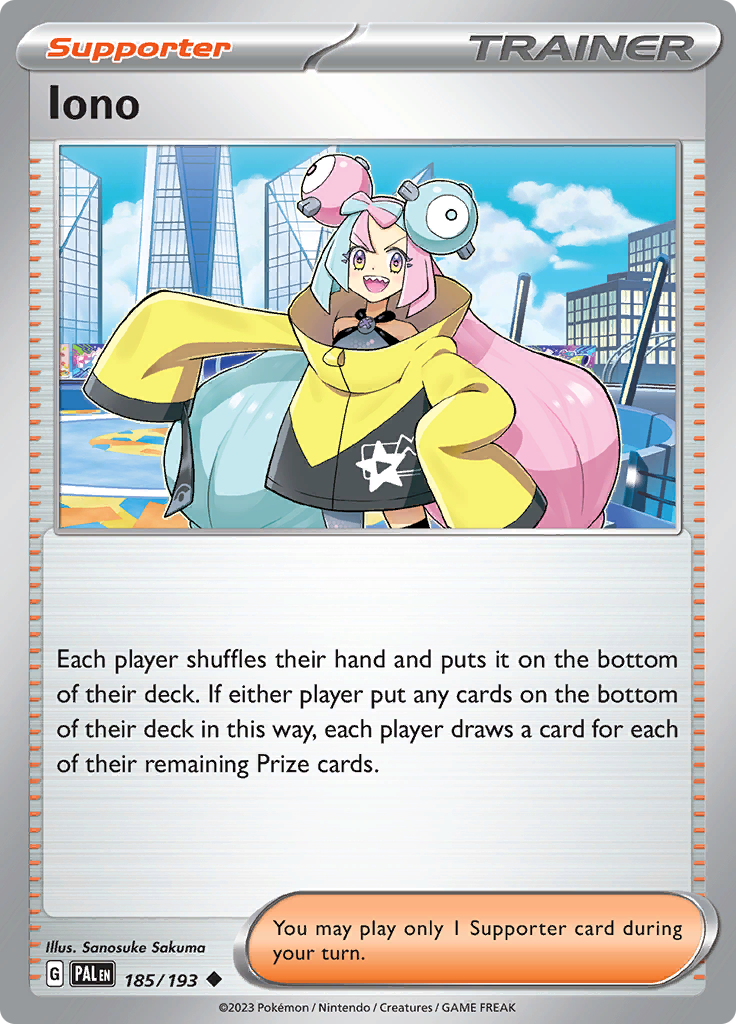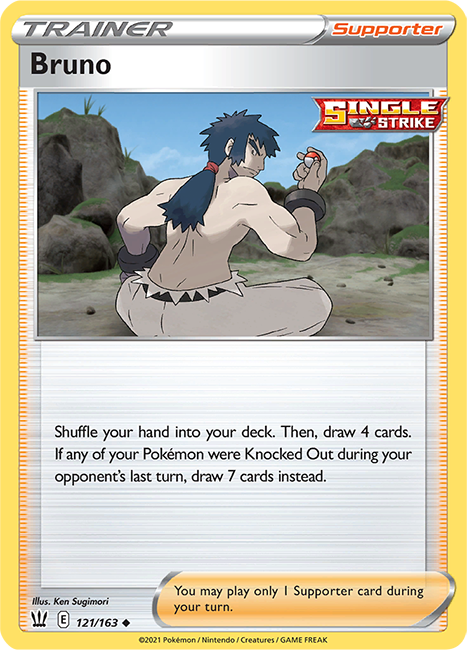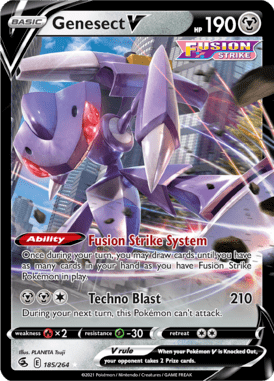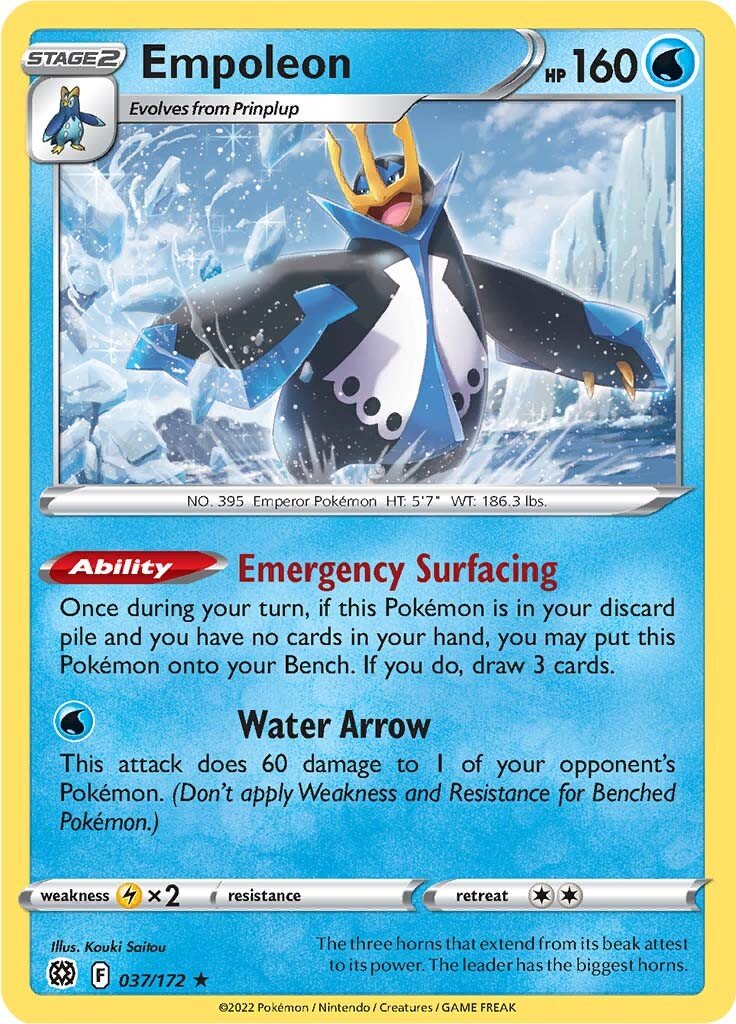Draw Cards
A deck’s Draw Engine consists of the resources it uses to draw into more cards. Most often, the most dominant part of any draw engine is its Draw Supporters—or the Supporter cards included in the deck expressly for their ability to draw their player additional cards. There are many draw supporters, but below are six of the most common draw supporters in the Standard format.
List of Important Draw Cards
Supporters
Class A
☆ Professor's Research SVI 190
☆ Iono PAL 185
Class B
Bruno BST 121
Korrina’s Focus BST 128
Melony CRE 146
Zinnia’s Resolve EVS 164
Cynthia’s Ambition BRS 138
Gardenia’s Vigor ASR 143
Colress’s Experiment LOR 155
Serena SIT 164
Judge SVI 176
Class C
Caitlin CRE 132
Shauna FST 240
Worker SIT 167
Youngster SVI 198
Pokémon
Kricketune V BST 6
Suicune V EVS 31
Pyukumuku FST 77
Genesect V FST 185
Empoleon BRS 37
Liepard BRS 91
Zamazenta V BRS 105
Bibarel BRS 121
Radiant Greninja ASR 46
Wyrdeer ASR 69
Regidrago ASR 118
Rotom V LOR 58
Comfey LOR 79
Kirlia SIT 68
Squawkabilly ex PAL 169
Items
Gutsy Pickaxe ASR 145
Trekking Shoes ASR 156
Stadium Cards
Tower of Darkness BST 137
Jubilife Village ASR 148
Special Energy
Gift Energy LOR 171
Supporters
Class A
Draw Supporters in Class A are the best Draw Supporters currently in the game. These are the Draw Supporters you’ll see most often—and with good reason.
☆ COMMON INCLUSION
Professor’s Research is the Standard format’s most powerful draw supporter. While Professor’s Research’s effect can be destructive to hands with key cards, its ability to draw 7 cards is unmatched in the Standard format.
Decks that run Professor’s Research may have to run recovery cards, like Ordinary Rod, to recover key components. These decks may also need to run slightly elevated copies of critical cards.
Many decks run 3-4 copies of Professor’s Research.
☆ COMMON INCLUSION
Although Iono does not draw as many cards for the player as Professor’s Research, Iono is especially potent as both a means of ensuring you don’t draw into the same bad hand and disrupting your opponent’s good hand.
Decks that run Iono typically include 3-4 copies.
Class B
Draw Supporters in Class B are excellent supporters that have a smaller niche than Draw Supporters in Class A. These situationally-handy cards might not make sense in every deck, but they can be pure gold in the right deck.
Bruno both offers a shuffle and draw option that doesn’t potential benefit your opponent and offers a bit of a boost to you after one of your Pokémon is knocked out. If you find that your Pokémon are knocked out each turn—especially if you’re playing a deck focused around single prize attackers—you may find Bruno to be a helpful addition to your deck.
Korrina’s Focus ensures that your hand stays filled by letting you draw until you have six cards in it. This means that decks that find themselves easily able to get down to a small hand size can make especially potent use of Korrina’s Focus. What’s more, decks that include Octillery BST can find Korrina’s Focus by making use of Octillery’s Rapid Strike Search ability.
Melony may not draw nearly as many cards as Professor’s Research, but its secondary effect—attaching a Water Energy from your discard pile to one of your Pokémon V—means that your Pokémon can be out and attacking faster than they would otherwise.
Decks that make use of Melony tend to use 4 copies of the card.
Zinnia’s Resolve can be a potent draw supporter in metagames where players are likely to play down many Pokémon early in the game. Depending on your opponent’s board size, Zinnia’s Resolve can draw nearly the same number of cards for you as Professor’s Research, but with a less costly discard requirement.
Decks that include Zinnia’s Resolve tend to run 1 to 2 copies of the card.
Cynthia’s Ambition is an especially strong draw Supporter option for decks build primarily around Pokémon that give up just a single prize card when knocked out. As decks can now easily thin their hand with cards like Ultra Ball, Cynthia’s Ambition will often mean that decks will see nearly the full potential draw from the card quite often, meaning that drawing 5 or even 8 cards with Cynthia’s Ambition isn’t out of the realm of possibility.
Decks that include Cynthia’s Ambition tend to run 2-4 copies of the card.
Gardenia’s Vigor may draw just two cards, but its secondary effect—attaching up to two Grass Energy cards from your hand to one of your benched Pokémon—means that your Pokémon can be out and attacking faster than they would otherwise. Furthermore, Gardenia’s Vigor allows you to attach those Energy cards after you draw the two cards, making it possible to attach Grass Energy you draw into with its effect.
Decks that make use of Gardenia's Vigor tend to use 2-4 copies of the card.
Colress’s Experiment pulls the top five cards from your deck and lets you choose two of them to put in the Lost Zone and three to put into your hand. In combination with other components of the Lost Engine, like Comfey LOR 79 and Mirage Gate, Colress forms a key part in a very strong energy acceleration and draw engine.
Only decks focused on interaction with the Lost Zone and the Lost Engine are likely to ever use Colress’s Experiment. Those decks will run 4 copies of the card. Others will not use it.
Serena works well because of the huge flexibility it offers. Although not especially strong as a draw card, it does still offer a means of drawing cards when other, stronger options aren’t available to you. Whereas Boss’s Orders is a card that can’t draw you cards in an otherwise dead hand, Serena can. And like Boss’s Orders, Serena offers the option to gust one of your opponent’s benched Pokémon. However, Serena’s gusting power is limited to benched Pokémon V (including VSTAR, VMAX, and V-UNION.) Single prize Pokémon and Pokémon ex aren’t possible gusting targets for Serena.
Decks that often find themselves gusting Pokémon that aren’t Pokémon V won’t find a lot of use for Serena. However, some decks will still run 1-2 copies of the card.
Judge draws just four cards but disrupts your opponent’s hand in the process. Unlike Iono, Judge shuffles both players’ hands into their deck, making it possible for the player to draw back into the cards that have been shuffled away. This makes Judge an inherently weaker disruption card than Iono and, as it draws one less card than Iono in the early game, it’s also a weaker Draw supporter.
Because of the popularity of Iono, Judge has to compete with it for deck space. Decks that run Judge tend to be very disruption-focused and will often run several of copies of it in addition to Iono.
Class C
Draw Supporters in Class C are mostly outclassed by Draw Supporters in Classes A and B. In very specific situations, these cards may still prove useful in deck construction.
The strength of Caitlin depends on how easily your deck can increase your hand size in other ways, like Pokémon-based card draw. Generally, if your deck is already drawing a large number of cards via alternate methods, a card like Caitlin may end up not proving especially helpful. However, if you’re able to build up a large hand size, Caitlin can be a great way to cycle cards from your hand that aren’t helping you now—but could later.
Shauna and Youngster offer a simple shuffle and draw effect that draw their player 5 cards. Unlike Iono, the player who uses these cards is able to draw back into some or even all of the 5 cards shuffled away. This may be helpful if your deck has a number of critical 1-of or 2-of pieces that find themselves in your hand at the same time.
However, because of the popularity and superiority of Iono as a draw Supporter, Shauna and Youngster see next to no play.
Worker’s usefulness is not primarily in how many cards it draws you, but in its additional functionality: removing a hostile Stadium card from play.
In decks that are easily shut down by a hostile Stadium cards like Path to the Peak, Lost City, or Temple of Sinnoh, Worker is an additional option for removing the hostile stadium from play.
A little overwhelmed by the choices? That’s okay. Below is a generic set of Draw Supporters to help get you drawing cards and setting up your strategy without a sweat. Once you’ve gotten familiar with your deck, you can come back to your Draw Supporters and tweak them so that they work even better for you and for your strategy!
| General Draw Set |
| 4 Iono PAL 185 4 Professor's Research SVI 190 |
Pokémon
Kricketune V is a handy option for decks that often find themselves with a small number of cards in their player’s hand. Kricketune V helps ensure that there’s the option to draw just a bit more, meaning disruption effects like a late-game Iono won’t have quite as much sting when Kricketune V’s Exciting Stage ability is at the ready.
Decks that run Kricketune V tend to include just 1 copy.
Although Suicune V’s Fleet Footed ability isn’t the most potent—it draws just a single card. However, in conjunction with Altaria EVS 106’s Tempting Tune ability which searches out and places a Supporter card from your deck on the top, it means that you’ll often have access to the Supporter card you need when you need it.
Additionally, Suicune V can be a decent alternate attacker in decks that play either Water Energy or Aurora Energy.
Pyukumuku’s Pitch a Pyukumuku draw effect may seem underwhelming, especially as you can only use a single Pitch a Pyukumuku ability in a turn, but drawing a single card via a Pokémon searchable via Level Ball and Quick Ball can be the difference between finding what you need to take a knockout and narrowly missing it.
Pyukumuku isn’t an especially common inclusion in decks—those that do run the card tend to include just a single copy.
Genesect V is an extremely potent draw Pokémon for decks built around Fusion Strike Pokémon. Its Fusion Strike System ability can be used up to four times in a turn (one time for each Genesect V you have in play), meaning that, even without using your Supporter card for the turn to draw cards, it’s possible to draw as many as 24 cards in a single turn!
Decks that run Genesect V tend to run 4 copies of the card.
Empoleon works a bit like a “get out of jail free” card for when you’d otherwise be stuck in top-deck mode—that is, when you’ll have become reliant on the single card you draw at the start of your turn.
If you have a free spot on your bench, Empoleon can be an out to drawing a few extra cards and can mean the difference between staying bricked or advancing your deck’s strategy. However, your deck must first have operated well enough to get Empoleon into the discard pile in the first place. For decks that include the energy required to use its Water Arrow attack, Empoleon can also be a decent single prize attacker to finish off weakened Pokémon—especially those on your opponent’s bench if they don’t have Wave Veil Manaphy to protect them.
Decks tend not to include Empoleon, but a deck that would include the card would include just a single copy.
Liepard’s Trade is one of the most powerful multiple use draw abilities ever printed in the Pokémon Trading Card Game. Trade allows you to thin your hand (and by extension, your deck), all while drawing more cards to help you find the pieces you need to execute your deck’s winning strategy. However, unlike Cinccino with its identical Make Do ability, Liepard’s 100 HP means that it is not searchable via Level Ball.
Decks tend to run Cinccino over Liepard, but a deck that runs Liepard would likely run 3-4 copies, in combination with 3-4 copies of the Basic Pokémon, Purrloin.
Zamazenta V has an ability that, at first glance, may feel reminiscent of Dedenne-GX’s Dedechange, but with the advantage of it being an ability that you can use more than once from the same Zamazenta V. However, because Regal Stance ends your turn, you may often find yourself unable to make timely use of any cards you draw from its effect and will likely be better served by alternative drawing options, like Kricketune V’s Exciting Stage.
Decks tend not to include Zamazenta V.
Bibarel’s Industrious Incisors is an extremely potent, repeatable draw option that, paired with hand-thinning cards like Ultra Ball, means a deck that makes use of it can draw quite a few of cards each turn, without even using a Supporter card!
Decks that run Bibarel tend to run 2-3 copies of the card in combination with 3 copies of the Basic Pokémon, Bidoof.
Radiant Greninja is the most powerful of all of the Radiant Pokémon so far and is an automatic inclusion in many decks. Its Concealed Cards ability turns an Energy card into a “draw 2” option, all while putting Energy in the discard pile for cards like Melony that can make use of the discarded Energy.
Many decks run Radiant Greninja. As Radiant Greninja is a Radiant Pokémon, decks can run a maximum of 1 copy of the card—and cannot play any other Radiant Pokémon.
Wyrdeer and its Hurried Gait ability may not fit in many decks—or indeed in most decks—but it’s a draw option worth considering all the same. Wyrdeer’s ability simply draws you a card with no other requirements—no hand size limitations, no need to discard a card, nothing. Just a simple draw 1.
Most decks won’t run Wyrdeer—but those that would run it would most likely include 2-3 copies of Wyrdeer, plus 2-3 copies of the Basic Pokémon, Stantler.
Regidrago is a handy option for decks that often find themselves with a small number of cards in their player’s hand, much like Kricketune V, but with the benefit of being a single prize Pokémon. Regidrago helps ensure that there’s the option to draw just a bit more, provided you can get it into the Active Spot.
Though most decks would not choose to run Regidrago, decks that do would include 1-2 copies of the card.
Rotom V and its Instant Charge is there for you when your only other option is to pass to your opponent. Instant Charge draws you three cards in exchange for ending your turn.
Many decks will not run Rotom V, as other options that don’t end your turn exist, but decks that run Rotom V will often include 1-2 copies of the card.
Comfey’s Flower Selecting pulls the top two cards from your deck and lets you choose one of them to put in the Lost Zone and has you put the other into your hand. In combination with other components of the Lost Engine, like Colress’s Experiment and Mirage Gate, Comfey forms a key part in a very strong energy acceleration and draw engine.
Only decks focused on interaction with the Lost Zone and the Lost Engine are likely to ever use Comfey. Those decks will run 4 copies of the card. Others will not use it.
Kirlia’s Refinement is one of the most powerful multiple use draw abilities ever printed in the Pokémon Trading Card Game. Refinement allows you to thin your hand (and by extension, your deck), all while drawing more cards to help you find the pieces you need to execute your deck’s winning strategy.
Decks that run Kirlia tend to run 3-4 copies, in combination with 3-4 copies of the Basic Pokémon, Ralts, and 1-2 copies of the stage 2 Pokémon, Gallade.
Squawkabilly ex’s Squawk and Seize is the perfect Squawkability to get a deck desperate for early draw (and early discards) moving. On only your first turn, after using many of the resources in your hand, you can play down Squawkabilly ex—and even search it out via Nest Ball—and use its Ability to discard your hand and draw 6 new cards to push your deck further toward achieving its game plan.
Most decks don’t run Squawkabilly ex, but those that do tend to run 1-2 copies of the card.
Items
Gutsy Pickaxe is an Item card that draws you another card, effectively turning your deck into a 56-card deck when you play 4 copies of the card. As an additional benefit, if the card it draws into is a basic Fighting Energy, you are able to attach it to one of your Benched Pokémon—providing a small bit of acceleration.
Decks that can make use of Gutsy Pickaxe tend to run 3-4 copies.
Trekking Shoes, like Gutsy Pickaxe, effectively turns your deck into a 56-card deck. However, although Trekking Shoes does not have the benefit of attaching an Energy if it is the card that Trekking Shoes draws into, Trekking Shoes can dig one additional card deeper if the player chooses to discard the first card they drew off of it. This makes Trekking Shoes a great option for decks that want cards in their discard piles, and also adds a nice bit of consistency through the Item-based draw power it provides.
Decks that make use of Trekking Shoes tend to include 4 copies of the card.
Stadium Cards
Tower of Darkness turns any Single Strike card in your hand—even another Tower of Darkness—into a way to draw two cards. This boost in draw power can be great for Single Strike decks that need to find a card or two to pull off their strategy and just need to dig a big further.
Two cards may not seem like a lot, but it adds up!
Jubilife Village is a Stadium-based draw option for decks that don’t often find themselves attacking the opponent’s Active Pokémon—especially for decks that rely on the Stall win condition to take the victory from the opponent, but don’t need to stockpile specific cards in the player’s hand. However, even decks like these may be better served by Snorlax VIV 131.
Because use of Jubilife Village ends your turn when it is used, it won’t often find itself in decks. Decks that do find themselves interested in using Jubilife Village will likely run 3-4 copies of the card.
Special Energies
Gift Energy offers additional draw when one of your Pokémon is Knocked Out, acting as a rebound option that helps you draw into cards necessary to respond with a knockout of your own. Decks that lean heavily on non-Draw Supporters or on Draw Supporters with weaker draw effects (Draw 2, 3, or 4), like Gardenia, tend to benefit the most from Gift Energy.
Decks tend not to run Gift Energy, but those that would want it tend to run 3-4 copies.

